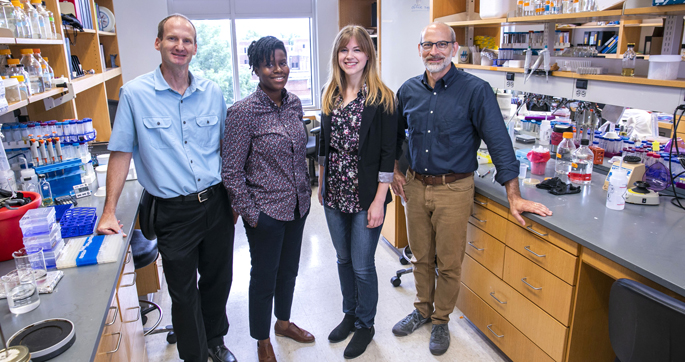MSTPublications: July 2019
 Anatomical context improves deep learning on the brain age estimation task.
Anatomical context improves deep learning on the brain age estimation task.
Bermudez C, Plassard AJ, Chaganti S, Huo Y, Aboud KE, Cutting LE, Resnick SM, Landman BA.
Magn Reson Imaging. 2019 Jun 24. pii: S0730-725X(18)30609-X. doi: 10.1016/j.mri.2019.06.018. [Epub ahead of print]
Deep learning has shown remarkable improvements in the analysis of medical images without the need for engineered features. In this work, we hypothesize that deep learning is complementary to traditional feature estimation. We propose a network design to include traditional structural imaging features alongside deep convolutional ones and illustrate this approach on the task of imaging-based age prediction in two separate contexts: T1-weighted brain magnetic resonance imaging (MRI) (N = 5121, ages 4-96, healthy controls) and computed tomography (CT) of the head (N = 1313, ages 1-97, healthy controls). In brain MRI, we can predict age with a mean absolute error of 4.08 years by combining raw images along with engineered structural features, compared to 5.00 years using image-derived features alone and 8.23 years using structural features alone. In head CT, we can predict age with a median absolute error of 9.99 years combining features, compared to 11.02 years with image-derived features alone and 13.28 years with structural features alone. These results show that we can complement traditional feature estimation using deep learning to improve prediction tasks. As the field of medical image processing continues to integrate deep learning, it will be important to use the new techniques to complement traditional imaging features instead of fully displacing them.
 Fitness barriers limit reversion of a proofreading-deficient coronavirus.
Fitness barriers limit reversion of a proofreading-deficient coronavirus.
Graepel KW, Agostini ML, Lu X, Sexton NR, Denison MR.
J Virol. 2019 Jul 24. pii: JVI.00711-19. doi: 10.1128/JVI.00711-19. [Epub ahead of print]
The 3′-to-5′ exoribonuclease in coronavirus (CoV) nonstructural protein 14 (nsp14-ExoN) mediates RNA proofreading during genome replication. ExoN catalytic residues are arranged in three motifs: I (DE), II (E), III (D). Alanine substitution of the motif I residues (AA-E-D, four nucleotide substitutions) in murine hepatitis virus (MHV) and SARS-CoV yields viable mutants with impaired replication and fitness, increased mutation rates, and attenuated virulence in vivo Despite these impairments, MHV- and SARS-CoV ExoN motif I AA mutants (ExoN-AA) have not reverted at motif I in diverse in vitro and in vivo environments, suggesting that profound fitness barriers prevent motif I reversion. To test this hypothesis, we engineered MHV-ExoN-AA with 1, 2 or 3 nucleotide mutations along genetic pathways to AA-to-DE reversion. We show that engineered intermediate revertants were viable but had no increased replication or competitive fitness compared to MHV-ExoN-AA. In contrast, a low passage (P10) MHV-ExoN-AA showed increased replication and competitive fitness without reversion of ExoN-AA. Finally, engineered reversion of ExoN-AA to ExoN-DE in the presence of ExoN-AA passage-adaptive mutations resulted in significant fitness loss. These results demonstrate that while reversion is possible, at least one alternative adaptive pathway is more rapidly advantageous than intermediate revertants and may alter the genetic background to render reversion detrimental to fitness. Our results provide an evolutionary rationale for lack of ExoN-AA reversion, illuminate potential multi-protein replicase interactions and coevolution, and support future studies aimed at stabilizing attenuated CoV ExoN-AA mutants.IMPORTANCECoronaviruses encode an exoribonuclease (ExoN) that is important for viral replication, fitness, and virulence, yet coronaviruses with a defective ExoN (ExoN-AA) have not reverted under diverse experimental conditions. In this study, we identify multiple impediments to MHV-ExoN-AA reversion. We show that ExoN-AA reversion is possible but evolutionarily unfavorable. Instead, compensatory mutations outside of ExoN-AA motif I are more accessible and beneficial than partial reversion. We also show that coevolution between replicase proteins over long-term passage partially compensates for ExoN-AA motif I but renders the virus inhospitable to a reverted ExoN. Our results reveal the evolutionary basis for the genetic stability of ExoN-inactivating mutations, illuminate complex functional and evolutionary relationships between coronavirus replicase proteins, and identify potential mechanisms for stabilization of ExoN-AA coronavirus mutants.

Scott Beeler’s (M3) recent first-author publication was featured here in the VUMC Reporter!

Petria Thompson’s (G4) recent first-author publication was featured here in the VUMC Reporter!
Association between First Trimester Antidepressant Use and Risk of Spontaneous Abortion.
Wu P, Velez Edwards DR, Gorrindo P, Sundermann AC, Torstenson ES, Jones SH, Chan RL, Hartmann KE.
Pharmacotherapy. 2019 Jul 6. doi: 10.1002/phar.2308. [Epub ahead of print]